Memory Scaling on Core i7 - Is DDR3-1066 Really the Best Choice?
by Gary Key on June 24, 2009 9:00 AM EST- Posted in
- Memory
Even though our DDR3-2000 kits were not cooperating with us, we were able to run a few benchmarks to determine which memory setting would be ideal at our 3.8GHz (19x200) processor speed. We arrived at this clock speed, as it is a free overclock with only VTT needing to be increased to handle our particular memory speeds and timings. We will take a look at other overclocked speeds and memory settings in the near future.
Everest 5.02.1765
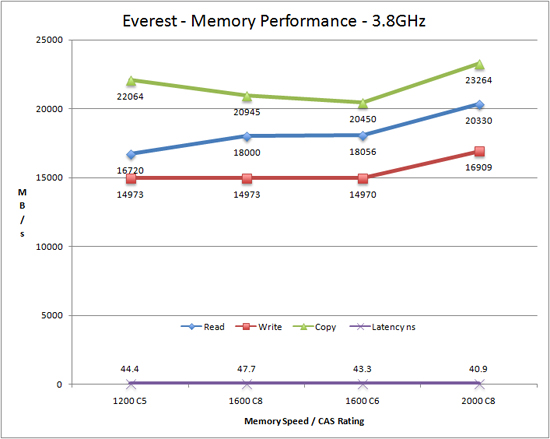
Going from 1250 C5 to 2000 C8 nets a 5% improvement in memory reads, 21% in writes, 13% in copy speeds, and 8% in latency. Interestingly enough, 1200 C5 provides excellent results compared to 1600 C8 and our application benchmarks reflect this fact.
AutoCAD 2009 x64
We utilize AutoCAD 2009 x64 and the Cadalyst Labs benchmark.

Just like our stock clock results, the 3D scores are respond better to the slower memory speeds. Once again, decreased latencies and greater bandwidth generally resulted in improved 2D and CPU scores.
3ds Max 2009 x64
We utilize a rather large mental ray image and track the time it takes to render it.
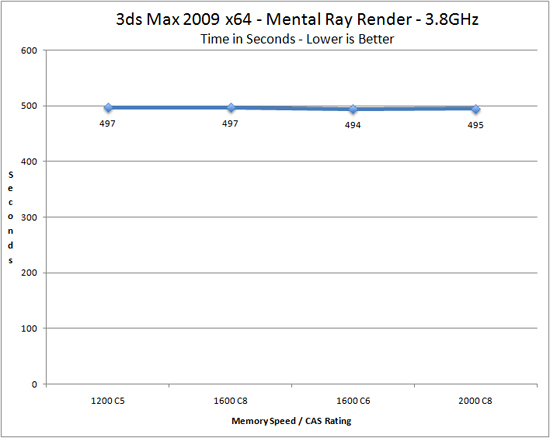
In our stock test we measured a 3% increase in performance (19 second reduction) moving from DDR3-1066 C7 to DDR3-1600 C6. In our overclock test the 2 second difference between 1200 C5 and 2000 C7 is minimal as clock speed is king at this point.
LightWave 3D 9.6 x64
We time the rendering of a single frame from an office building animation. The time to render the full scene is approximately four and a half hours.
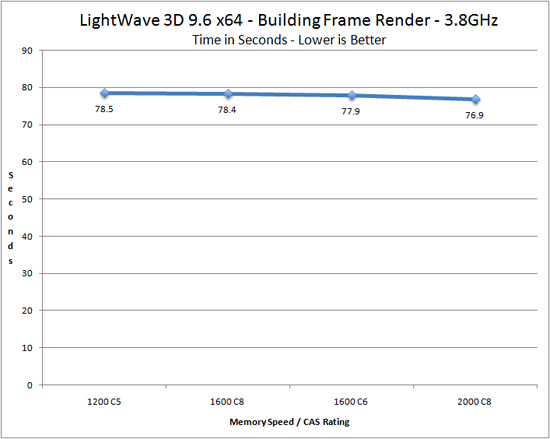
The stock test revealed a 6% advantage for DDR3-1866 C7 over DDR3-1066 C7. The overclock test indicates a 2% advantage for 2000 C8 compared to 1200 C5.
WinRAR 3.9b3 x64
This benchmark compresses our AT workload consisting of a main folder that contains 954MB of files in 15 subfolders. The result is a compressed file approximately 829MB in size.
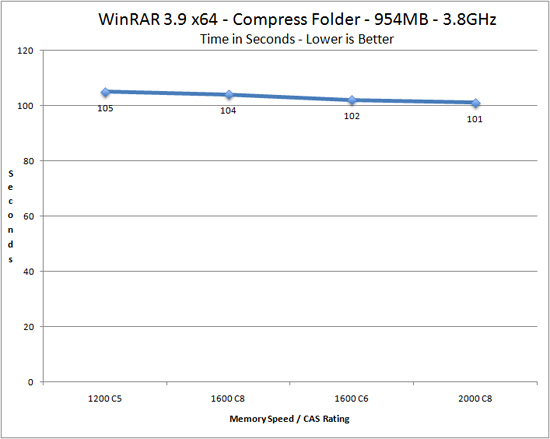
In our stock tests, going from DDR3-1066 C7 to DDR3-1866 C7 resulted in a 20% decrease in processing time. With our processor overclocked to 3.8GHz, this benchmark provides a 4% increase in performance when moving from 1200 C5 to 2000 C8.
MainConcept Reference 1.61
We set our profile to iPOD HQ NTSC and then transcode a 651MB 1080P file to a iPOD friendly 34.7MB file.
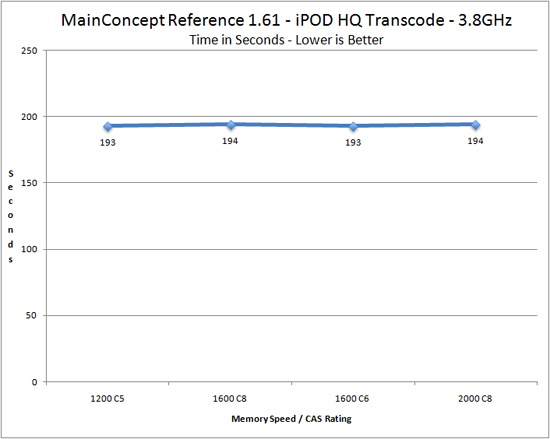
Our stock test showed a 3% improvement in performance when scaling from DDR3-1066 to DDR3-1866. Overclocking our system resulted in a .05% variation in the score with our two low latency settings performing ever so slightly better.










47 Comments
View All Comments
BrianInfo - Thursday, July 30, 2009 - link
1.) The recommended DDR3-1066 Patriot PSD36G1066KH is non-ECC and unbuffered. Will this be an issue for the personal desktop use, mainly for video/audio transcoding/muxing?
2.) The article does not specify how to achieve the CAS5. Does anyone succeed the CAS5 with this Patriot DDR3-1066 and/or overclocked DDR3-1200?
3.) Is it possible to achieve the CAS5 with other brand, such as GeIL CAS7 GV36GB1066C7TC or Crucial CT3KIT25664BA1067??
4.) According to Tom's Hardware, not all the X58 motherboards support CAS5 http://www.tomshardware.com/reviews/cheap-x58-moth...">http://www.tomshardware.com/reviews/cheap-x58-moth...
so does it mean I cant obtain the ideal performance with the combination of "ASRock X58 Extreme" motherboard with "Patriot PSD36G1066KH" Tweaked-CAS5 DDR3? I really like the Asus P6T SE but the layout of the two (blue) PCI Express 2.0 x16 slots, too close to each other is killing me:(
iwodo - Sunday, June 28, 2009 - link
Spend the extra money on an SSD rather then faster Memory. Although i would love to see how Tri Channel differs from Dual Channel. ( Same results? )And how integrated Graphics differs in memory speed.
lemonadesoda - Friday, June 26, 2009 - link
Gary, you obviously get paid by wordcount. Too much waffle. Get to the meat faster.And what about this $200 between cheap and expensive DDR3 kits? How about seeing WHERE that $200 could have been spent in OTHER upgrades, ie. CPU or GPU, and running benchmark comparisons against THAT setup vs. the first.
Otherwise, thanks for running all the tests and creating the data for us to review :-)
PrinceGaz - Thursday, June 25, 2009 - link
As soon as I looked at the chart on the first page of the article, it was clear that the DDR3-1600 C9 memory would represent the best bang for the buck. It was only marginally higher priced than the DDR3-1066 C7 (and the DDR3-1066 C5 doesn't count as you overclocked the DDR3-1066 C7 for that purpose), and was sure to perform at least as good, and probably better than significantly higher priced DDR3-1333 modules at C8, and almost as good as the DDR3-1333 C7.Given that faster memory modules only ever have a negligible effect on real-world performance (unless you are a pirate and spend a lot of time using PAR2 checkers to rebuild damaged files from newsgroups, or WinRAR to then extract the original files, the sort of stuff I certainly won't say I do), then you may as well get the cheapest brand-name memory available. If you're spending in the upper mid-range on your CPU, then go for slightly faster (like the 1600 C9) but still quite cheap memory-modules. The only people who should be getting those top-of-the-range modules or anything close to that price level are those who have already decided on the fastest Core i7 CPU avilable (i7 975 currently), as otherwise they're wasting their money on the wrong bit of hardware.
Souka - Thursday, June 25, 2009 - link
I'm more confused than ever... what to buy?Putting together a new system...
Win7 or Vista x64
i7-920 CPU
x58 MB
ATI 4890 video
Memory? I'd like to go with 6GB (3x2gb), thought I had my choices narrowed down to:
Opt1: $138 mushkin 6GB(3x2GB) 1333(PC3 10666) Model 998706, Cas6, 6-7-6-18
Opt2: $175 mushkin 6GB(3x2GB) 1600(PC3 12800) Model 998691. Cas6, 6-7-6-18
But after reading this article, and your comments... I'm very uncertain....help!
PrinceGaz - Thursday, June 25, 2009 - link
Given a choice between either DDR3-1333 or 1600 memory with identical timings (6-7-6-18), but a $37 price difference, I'd probably go for the 1333, especially as you have decided on an i7-920. If you want to spend a little more to improve yours sytem performance, the memory speed is the last place to look at to do so.SiliconDoc - Sunday, July 5, 2009 - link
I took just the opposite from it - he has a 4980 there - overclockable nicely, is saving quite a bit with lower cpu, and what else can get him another 2,5,7,14 % in framerates, especially minimum in some cases ? I think the higher ram is much better and worth it after seeing this articles results.He will OC the 4890 and the cpu likely, so that fast ram will give it that great finisging kick and make it awesome.
Spend the $37 and be happy - definitely.
Hrel - Thursday, June 25, 2009 - link
G.Skill 1.5-1.6v 1333 Cas 8-8-8-21 = 65Crucial 1.8v 1333 Cas 6-6-6-20 = 64 (sold out right now)
OCZ 1.9v 1600 Cas 7-7-7-24 = 54 (after 20 mail in rebate)
Patriot 1.9v 1600 Cas 7-7-7-20 = 95 (free shipping)
Patriot 2.0v 1600 Cas 7-7-7-20 = 100 (Green, which I like)
So basically, it really ONLY makes sense to buy the OCZ 1600 Cas 7 for 54 bucks, why pay more for less?!!!
sonci - Wednesday, June 24, 2009 - link
Really boring for me,lucky, I didnt read it all
StraightPipe - Wednesday, June 24, 2009 - link
cough * troll*